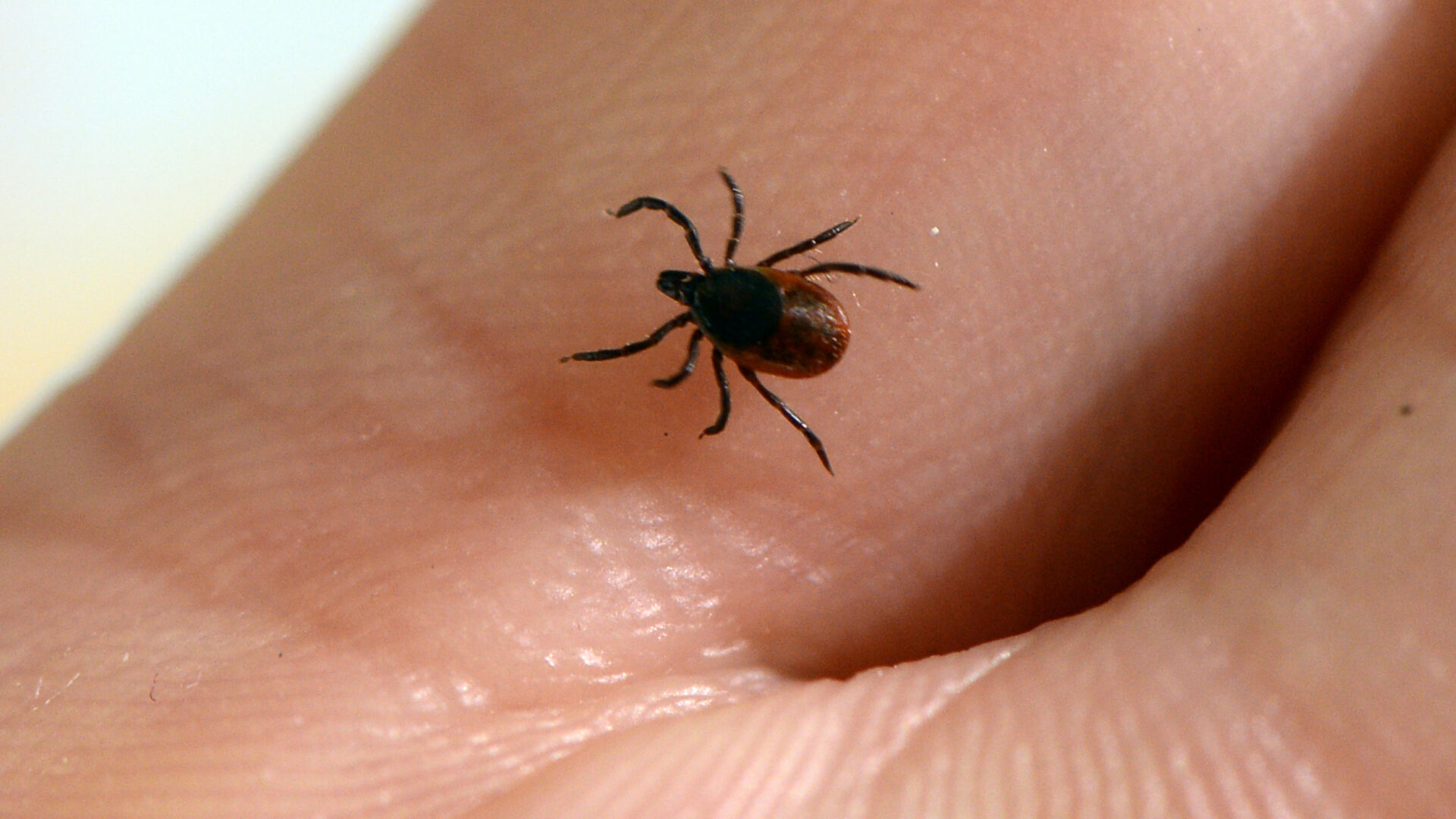
A picture taken at the French National Institute of Agricultural Research (INRA) in Maison-Alfort, on July 20, 2016 shows a tick, whose bite can transmit the Lyme disease. (Photo by BERTRAND GUAY / AFP) (Photo by BERTRAND GUAY/AFP via Getty Images)


A picture taken at the French National Institute of Agricultural Research (INRA) in Maison-Alfort, on July 20, 2016 shows a tick, whose bite can transmit the Lyme disease. (Photo by BERTRAND GUAY / AFP) (Photo by BERTRAND GUAY/AFP via Getty Images)

A picture taken at the French National Institute of Agricultural Research (INRA) in Maison-Alfort, on July 20, 2016 shows a tick, whose bite can transmit the Lyme disease. (Photo by BERTRAND GUAY / AFP) (Photo by BERTRAND GUAY/AFP via Getty Images)
 This story was produced as part of Climate Solutions, a collaboration focused on community engagement and solutions-based reporting to help Central Pennsylvania move toward climate literacy, resilience and adaptation. StateImpact Pennsylvania convened the collaboration; WITF is a Climate Solutions partner.
This story was produced as part of Climate Solutions, a collaboration focused on community engagement and solutions-based reporting to help Central Pennsylvania move toward climate literacy, resilience and adaptation. StateImpact Pennsylvania convened the collaboration; WITF is a Climate Solutions partner.
The largest study of its kind — focused on tiny ticks — is underway in Pennsylvania.
The PA Tick Research Lab, one of only three labs nationwide engaged in tick testing and research, is analyzing data from 30,000 tick exposures in Pennsylvania from 2019-2021.
The full study, expected to be released this summer, is not only compiling the tick intel, but is building prediction models designed to help reduce human exposure to ticks, and therefore lower future Lyme disease rates. That’s important because Pennsylvania is predicted to get warmer and wetter as a result of climate change, and ticks thrive in those conditions.
“We are trying to be on the leading edge of finding the next best way to combat the health crisis. This would be the first study — the largest sample size in any given state,” said Dr. Nicole Chinnici, laboratory director for the Northeast Wildlife DNA Laboratory, home of the PA Tick Research Lab. The lab is based at East Stroudsburg University and partially funded by the Pennsylvania Department of Health.
Pennsylvania has had the highest incidence of Lyme disease in the country in 11 of the past 12 years according to CDC data.
Firsts, in tick research
Chinnici, a certified wildlife forensic scientist who also has a doctorate in public health, has conducted research at the lab for eight years.
“[The study] is giving us a lot of valuable key information that we can turn around and use to educate the public,” Chinnici said. “We’ve been using a statistical approach to be able to predict where a tick would crawl and attach, based upon the type of activity you’ve been participating in.”
The results, she said, may be eye-opening for many.
“While a lot of people might think they’re most likely to encounter a tick in a state park,” Chinnici said, “in reality the most common exposure is in your own backyard.”
Predicting high-risk tick locations is just the beginning. Additional information generated by the tick prediction models relate to weather.
“If you look at areas that have high rates of tick-borne illnesses and tick exposures, it’s the Northeast and upper Midwest — and a lot of that has to do with our climate,” Chinnici said. “We have high relative humidity rates, and that allows ticks to extract moisture from the air to survive, so they don’t dry out. Ticks aren’t very good at surviving and adapting to dry heat or desert-like heat. The Northeast’s and upper Midwest’s temperate environment allow them to survive.”
According to the Pennsylvania Department of Health, Lyme disease is a bacterial infection carried by the blacklegged tick, also called the deer tick. Humans can be infected with Lyme disease through a tick bite. Both ticks and Lyme disease are present — some would say rampant — in all 67 Pennsylvania counties. Many cases of Lyme disease are transmitted by the nymphal deer tick — the size of the period at the end of this sentence. Lyme disease is the fastest-growing vector-borne infectious disease in the country, according to the Centers for Disease Control (CDC).
About 30,000 cases of Lyme disease are reported by state health departments annually—but that’s just a fraction of actual Lyme cases, as many cases aren’t properly diagnosed and states have differing reporting data. The CDC estimates as many as 476,000 people may be contracting Lyme annually. Children account for about 25% of Lyme cases.
The Environmental Protection Agency says the range of ticks is expanding in correlation with warming temperatures associated with climate change. Other factors supporting an expanding tick population are host species such as deer and white-footed mice, both of which are plentiful throughout Pennsylvania.
That’s why a second study underway at the PA Tick Lab focuses on white-footed mice in four Pennsylvania counties.
“They are one of the reasons Lyme has been spreading,” Chinnici said. “So we’re going to be vaccinating them against ticks and looking at how we can decrease the number of ticks feeding on these mammals, to ultimately reduce the number of ticks we’re seeing in the environment as well as the pathogens we’re seeing in those ticks.”
Chinnici and her research team are calculating the density of ticks in each area to track fluctuations.
The four Pennsylvania counties involved in the study are Monroe and Pike in the northeast and Crawford and Mercer in the northwest. Chinnici said they were strategically chosen: Those regions have the highest reported Lyme cases per 100,000 people. She said they’re working to get grant money to study more regions.
Both studies mark new territory for the lab — a move beyond information gathering and testing, into research.
“Our tick mitigation research is looking at strategies to reduce ticks and tick-borne illnesses,” Chinnici said, “and that’s one of our core missions — to be proactive instead of reactive to the pathogens we’re seeing and getting ahead of the bite.”
Data for the PA Tick Research Lab’s studies comes from a constant stream of old-fashioned letters received in the mail. The contents of those envelopes include ticks sealed in zipped plastic bags, accompanied by a numbered code that identifies that tick sample.
The lab’s website includes instructions on how to remove a tick, send it to the lab, and receive a pathology report (which reveals whether the tick was carrying Lyme or other pathogens) within 72 hours. While testing is free for Pennsylvania residents, there’s a fee for those out-of-state.
Since 2019, the lab has analyzed more than 100,000 ticks discovered by Americans nationwide. Testing relies on genetics and qPCR — the same technology used in COVID-19 tests. The data is available in real time on the website, broken down by state.
In Pennsylvania, 29% of the 65,135 ticks tested to-date were infected with Lyme or other bacteria.
Diagnosing the disease
Eric Huck called Pennsylvania “ground zero” for Lyme disease.
A Mechanicsburg resident, Huck is president and co-founder of the nonprofit PA Lyme Resource Network — an advocacy group for Lyme awareness, education and support. Like the PA Tick Research Lab, it’s partially funded by the state Department of Health. Huck contracted the disease nearly 15 years ago, and as he continues to battle symptoms, he’s also fighting for solutions.
“It’s time — this is such a mature health problem — we need to graduate to the next level by properly treating and diagnosing. Let’s start focusing on the humans. As a state, we’re not quite there — that’s the saber we’re trying to rattle,” Huck said.
That’s why the organization hosted a medical conference, for the fifth year in a row, in March. The event, held in partnership with the International Lyme and Associated Disease Society, was designed to help doctors learn how to diagnose and treat Lyme patients. It attracted 75 medical professionals, primarily from Pennsylvania and the Mid-Atlantic region, who earned continuing education credits.
One of those in attendance — for his third conference — was Dr. Robert Mauss of Gettysburg Osteopathic Family Health Center.
“Repetition is the mother of learning,” said Mauss, who estimated that he’s treated “thousands” of Lyme patients since 2012. His patients hail from a two-hour radius, and most have already been to a half-dozen or more doctors.
“They say, ‘Nobody can find out what’s wrong with me,’” Mauss said. “Many people are walking around with this complex list of symptoms and don’t know they have Lyme.”
Given the seemingly “perfect storm” of environment and climate supporting a plethora of ticks, Pennsylvania doctors may have a special burden to bear when it comes to learning how to diagnose and treat patients with tick-borne diseases.
“The burden is that there’s a lack of proper education for most primary care physicians in Pennsylvania — that’s why Eric Huck and his group are wonderful for what they’re doing,” Mauss said.
Tick-borne diseases are complicated. In addition to Lyme disease, every tick bite has the potential for any combination of nearly 20 additional bacterial strains.
“Ticks’ salivary glands are a pretty dirty place — so while you’ve got to be worried about Lyme, actually there are a lot of other things you could be exposed to,” Mauss said. “Early treatment is important, because the bacteria goes into the body trying to establish a presence. If you kill that bacteria before it gets a foothold, you’ve potentially prevented a lifetime of treatment. That can make a huge difference in the rest of a patient’s life.”
Overall, Chinnici said she’s encouraged by greater awareness of ticks, tick-borne diseases, and the links to climate change, weather and wildlife.
“I would say there are a lot more conversations starting to occur both on the state and federal level, on combating the health crisis as a result of ticks and tick-borne diseases,” she said. “Just five years ago, those conversations weren’t being had… (It) allows us to push for more funding, more research and more answers.”
Part 1 of this story, examining how Pennsylvania’s balance of nature is tipping amid climate change, and how collaborative research is mapping out wildlife’s future, is here.
The PA Lyme Resource Network maintains a referral list of Lyme Literate Medical Doctors (LLMDs) within the state, and presents educational programs, Dare 2B Tick Aware, aimed at Lyme and tick-borne disease prevention. Eric Huck, president and co-founder of the nonprofit PA Lyme Resource Network, said these programs are the nonprofit’s primary focus, “ongoing always” for two reasons: Prevention can literally save the lives of Pennsylvanians. And, Pennsylvania’s flourishing tick population means Lyme and tick-borne diseases are medical issues we’ll continue grappling with for years to come.
StateImpact Pennsylvania is a collaboration among WITF, WHYY, and the Allegheny Front. Reporters Reid Frazier, Rachel McDevitt and Susan Phillips cover the commonwealth’s energy economy. Read their reports on this site, and hear them on public radio stations across Pennsylvania.
(listed by story count)
StateImpact Pennsylvania is a collaboration among WITF, WHYY, and the Allegheny Front. Reporters Reid Frazier, Rachel McDevitt and Susan Phillips cover the commonwealth’s energy economy. Read their reports on this site, and hear them on public radio stations across Pennsylvania.
Climate Solutions, a collaboration of news organizations, educational institutions and a theater company, uses engagement, education and storytelling to help central Pennsylvanians toward climate change literacy, resilience and adaptation. Our work will amplify how people are finding solutions to the challenges presented by a warming world.